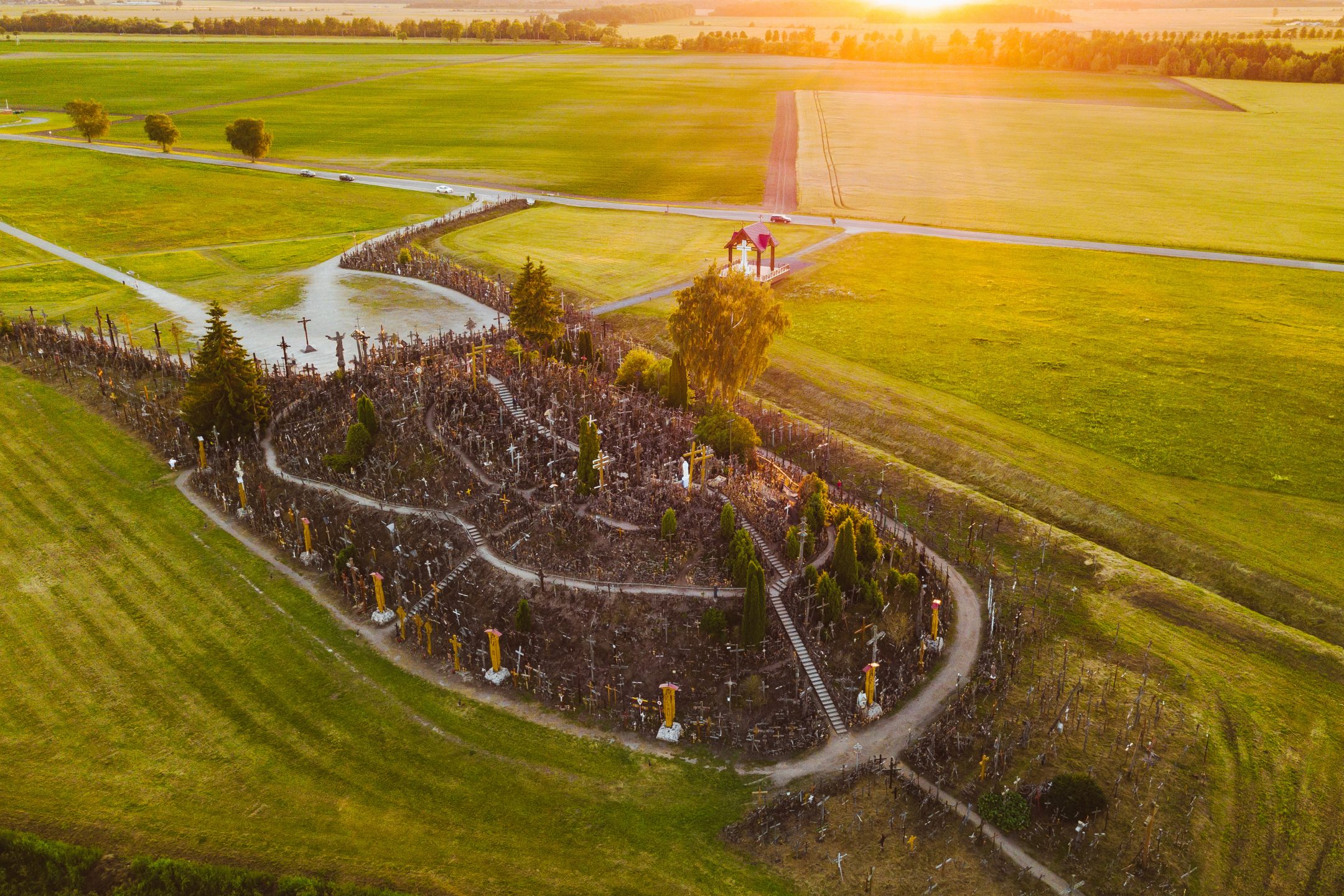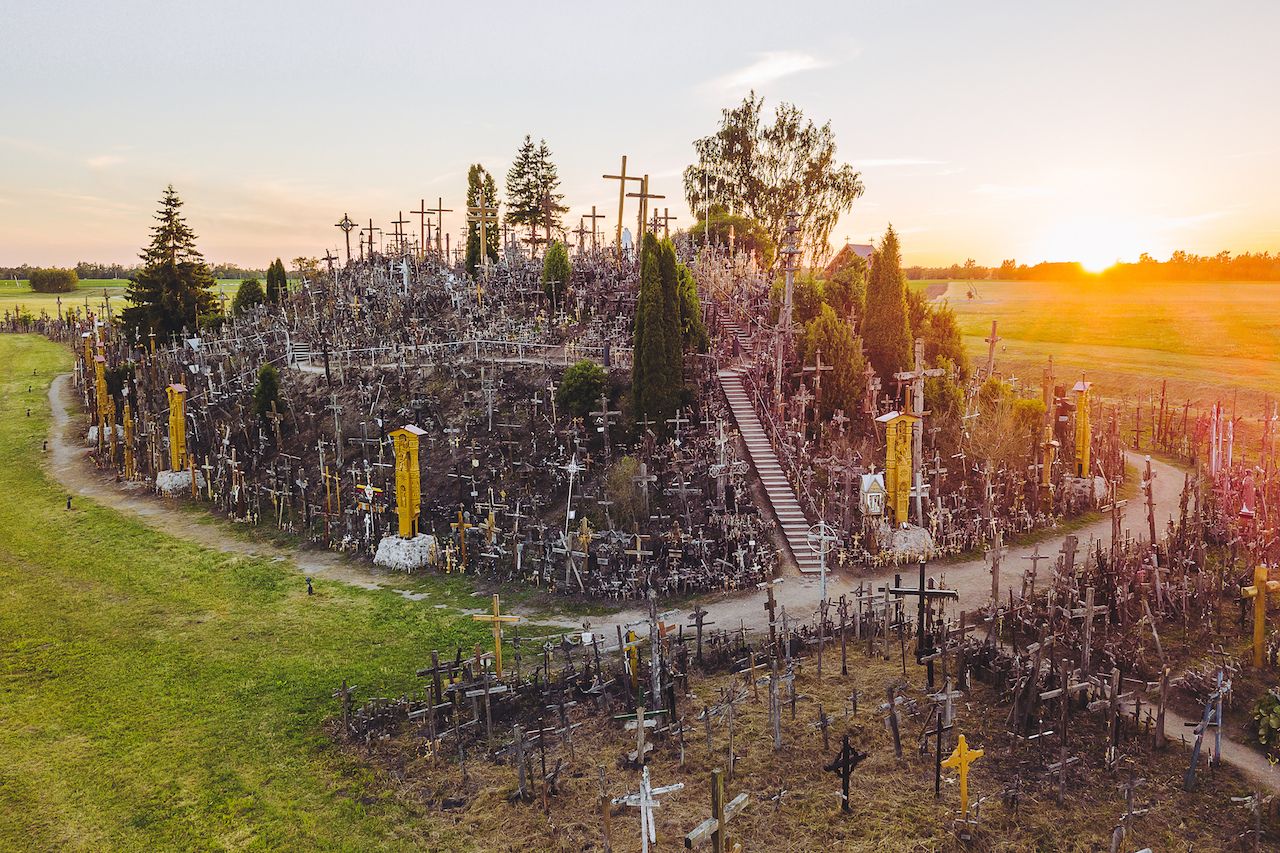



Hill of Crosses is a site of pilgrimage about 12 km north of the city of Šiauliai, in northern Lithuania. The precise origin of the practice of leaving crosses on the hill is uncertain, but it is believed that the first crosses were placed on the former Jurgaičiai or Domantai hill fort after the 1831 Uprising.
Spring to Autumn (May–October): Ideal for mild weather and full access to the site.
Early morning or late evening: Offers the most peaceful atmosphere and best lighting for photography.
Winter: Snow-covered crosses create a hauntingly beautiful, solemn ambiance.
Location: 12 km north of Šiauliai, in northern Lithuania.
By car: Easiest way—ample parking available near the entrance.
By public transport:
Take a bus or train to Šiauliai.
From Šiauliai, take a local bus or taxi to Jurgaičiai, the village closest to the site.
Walking/biking option: A 12 km hike or ride from Šiauliai for adventurous travelers.
Over 100,000 crosses: Covering the hill and continuing to grow. They range from tiny toothpick-sized crucifixes to enormous wooden and iron monuments.
Personal tributes: Visitors leave rosaries, photographs, handwritten prayers, and even wedding bands.
Pope John Paul II monument: Commemorating his 1993 visit and blessing of the site.
Chapel for meditation: A quiet space near the hill for reflection and prayer.
Leave your own cross: A spiritual or personal gesture. Bring one or buy from local artisans.
Photography: Excellent opportunities in all weather—especially misty or snowy mornings.
Reflect and walk: Wander through narrow paths surrounded by thousands of layered crosses.
Join pilgrimage (July 12): An annual Catholic mass and procession is held here.
Šiauliai: Closest city with hotels, guesthouses, and hostels.
Options: Hotel Turnė, Hotel Šiauliai, and Saulės Krantas Guest House.
Nearby villages: Limited rural homestays or countryside retreats for a quieter stay.
Šiauliai: Offers restaurants and cafes with local and European cuisine.
Try “Arkikatedra” or “Cask 426” for a local experience.
On-site café: Near the parking area for basic refreshments and snacks.
The local culture of the Hill of Crosses is deeply rooted in Lithuania's religious, historical, and national identity. Here’s a closer look at the cultural aspects surrounding this powerful site:
Catholic Faith: The Hill of Crosses is primarily a Catholic pilgrimage site. The crosses, placed by individuals over the years, reflect the enduring Catholic faith in Lithuania, especially during times of oppression. Pilgrims visit to honor the dead, ask for blessings, or fulfill promises.
Symbol of Resistance: During the Soviet era, the site became a symbol of resistance against religious repression. Despite Soviet attempts to demolish it, the Hill kept growing, symbolizing Lithuania’s defiance against the Soviet occupation and the strength of its national and spiritual identity.
Catholic Traditions: Many visitors leave rosaries, photographs, and handwritten prayers as tributes or requests for miracles. The site also hosts pilgrimages where masses and religious ceremonies are conducted, especially on significant Catholic days.
Historical Memory: The Hill of Crosses is a symbol of Lithuanian perseverance and resilience in the face of adversity. It stands as a memorial to those who have suffered and died for Lithuania's independence and freedom.
Symbol of Unity: The site unites people from all walks of life, transcending political and religious boundaries. It draws Lithuanians and visitors alike who leave behind their personal tributes as a way of connecting with the country's past struggles and ongoing national spirit.
Cross Carving: The craft of cross-making is deeply ingrained in Lithuanian culture. Visitors often purchase beautifully handcrafted wooden or metal crosses, made by artisans from the region. These crosses often feature traditional Lithuanian folk designs and motifs, reflecting local artistry.
Wooden Crafts: Apart from crosses, local artisans create other wood-carved religious symbols, icons, and sculptures, which are often sold at small kiosks near the hill.
Annual Pilgrimages: On July 12, a significant pilgrimage takes place at the Hill of Crosses, where thousands of Catholics gather for mass and prayers, paying tribute to the country's faith and cultural heritage.
Spiritual Reflection: Many people visit for personal reflection, bringing their own crosses or prayers as part of a spiritual journey. It's also a site of healing and hope, where individuals seek comfort and peace.
While the Hill of Crosses itself is a solemn space, Lithuanian culture has a rich folk tradition, with songs, chants, and hymns often tied to religious and historical events. Folk music is celebrated throughout the country and can be heard during festivals and ceremonies, further enhancing the sacred ambiance of the hill.
The Hill of Crosses is not just a tourist attraction, but a sacred space where respect and quiet reflection are highly encouraged. Visitors are expected to behave with reverence, acknowledging the site’s profound spiritual and cultural significance. It’s a place where silence speaks louder than words, and where the weight of the past and the power of faith come together.
The Hill of Crosses is not just a religious site, but a testament to Lithuania’s enduring culture of resistance, spirituality, and resilience. Its rich cultural significance makes it a deeply moving place for those who visit, whether for spiritual reasons or to experience Lithuania's historical and cultural heritage.